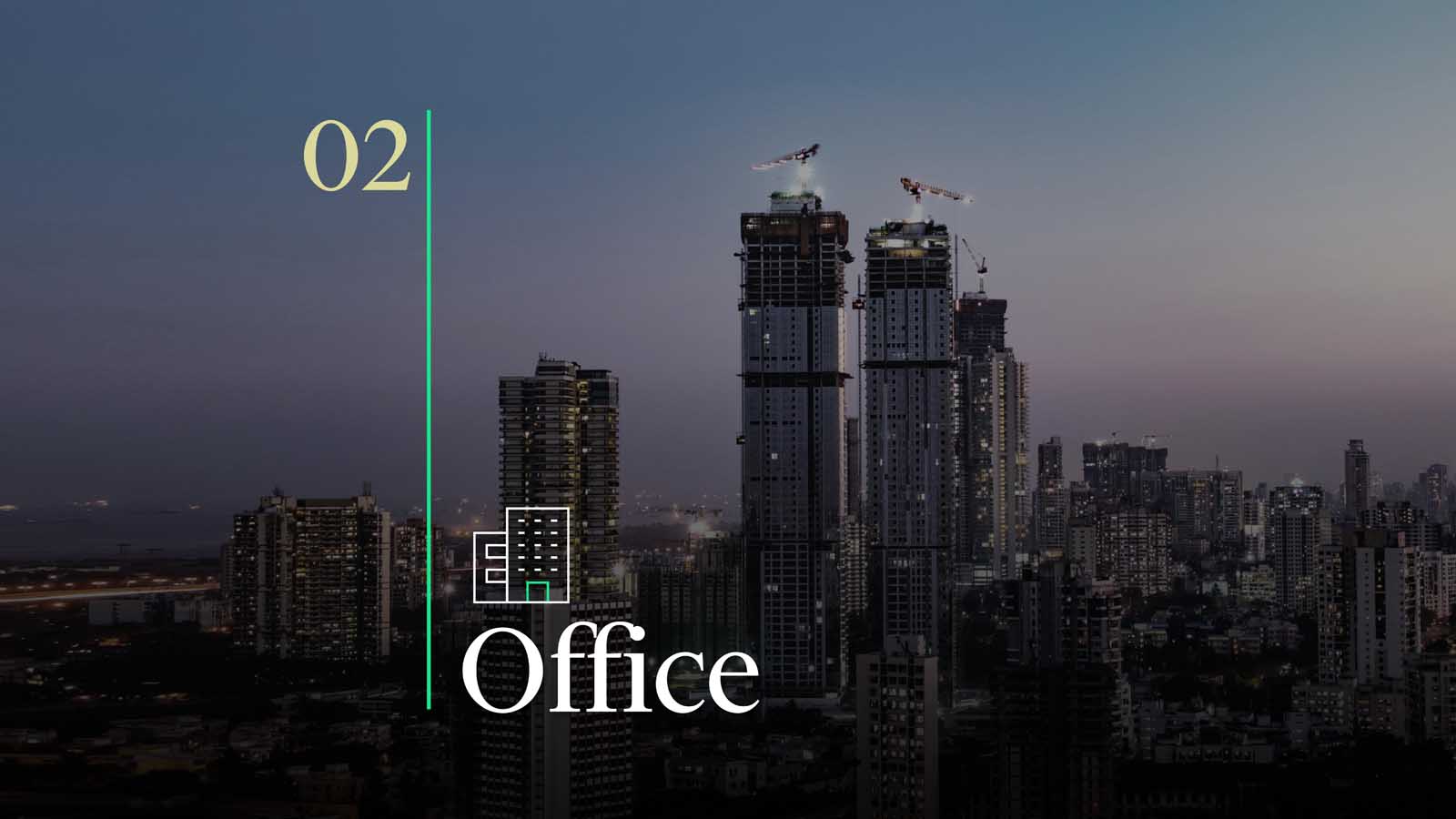Consultancy provides in-depth analysis and projections for a wide range of real estate sectors.
submitted by CBRE South Asia Pvt. Ltd.
At the Confederation of Indian Industry (CII) Realty 2023 Conference in New Delhi on September 27, CBRE South Asia Pvt. Ltd. released a report titled “Indian Real Estate: Taking Giant Strides — 2023 Mid-Year Outlook.” The CBRE-CII joint report highlights real estate growth in India, key trends and projections for the Indian real estate sector for the remainder of 2023.
According to the report, owing to developers’ and occupiers’ growing focus on sustainability, green-certified office stock in India has increased by more than 36% since 2019 to approximately 342 million ft2 across the top six cities in India. Bangalore, the Delhi-National Capital Region (NCR) and Mumbai are the top three cities spearheading green-compliant office spaces with a cumulative share of roughly 68% of the total, green-certified office stock in India as of June. Certified green office stock also increased substantially, growing at a CAGR, or compound annual growth rate, of 7.1% in the last five years.
Enhanced focus on global and domestic Environmental, Social and Governance (ESG) regulations is driving occupiers’ flight-to-quality wave toward modern, premium and sustainable spaces in the medium to long term. Sustainable building features and operations are increasingly becoming developers’ and occupiers’ most sought-after building attributes.
Bangalore tops all Indian cities with the highest green-compliant office stock, accounting for approximately 30% of the total pan-India stock, followed by the Delhi-NCR with 21% and Mumbai with 17% of the total certified office stock in India as of June. Green office stock in Hyderabad accounts for 15%, Chennai 9%, and Pune 8% of the total pan-India stock.
Global and domestic occupiers are prioritizing sustainability and have committed to targets with far-reaching impact. Global and national mandates, including the Corporate Sustainability Reporting Directive (CSRD), Enhancement and Standardization of Climate-Related Disclosures, and India’s Business Responsibility and Sustainability Reports (BRSR), push occupiers to continue leasing in next-generation, green-certified office spaces.
Anshuman Magazine, CBRE chairman and CEO for India, Southeast Asia, the Middle East and Africa, said:
“The Indian real estate sector has demonstrated remarkable resilience in January-June 2023 despite a global economic slowdown, primarily fueled by robust domestic demand. In line with most major economies globally, the rate hike cycle in India seems to have come to a halt, with the Reserve Bank of India maintaining the status quo in the past two reviews. As the economy gains momentum and the real estate sector thrives, there is a growing emphasis on ESG and its compliance. We anticipate accelerated demand for modern, tech-enabled and green-compliant spaces in the upcoming quarter. Additionally, we also expect alternative segments such as global capability center, data centers and flexible workspaces to play a pivotal role in bolstering real estate growth.”
Key Highlights
- Leasing activity across real estate assets withstood global headwinds in January-June and is expected to grow further in the July-December period.
- Office leasing activity was noted at about 26.4 million ft2 during January-June, with Bangalore, Chennai and the Delhi-NCR accounting for 60% of overall leasing.
- Space take-up in the Industrial & Logistics (I&L) sector grew by about 35% year-on-year (YoY), touching 19.1 million ft2 in January-June. With sustained leasing activity expected in July-December, I&L space take-up is likely to touch 36-38 million ft2 in 2023, marginally surpassing 2022 levels.
- Retail leasing grew by 24% YoY in January-June to 2.9 million ft2. Retailers and prominent developers alike are expected to continue exploring emerging untapped markets including tier-II, III and IV cities.
- Residential sales in January-June exceeded 150,000 units, surpassing sales reported in January-June 2022 and July-December 2022 by around 4% and 6%, respectively. Sustained momentum in demand led developers to launch more than 150,000 new housing units in January-June, marking an annual growth of 11%. Despite a lagged impact of monetary tightening, 2023 could well be the year with sales crossing the 300,000-unit mark by the year-end.
- While transaction closures were muted in January-June, we expect investment activity to pick up pace in July-December, considering the strong deal pipeline. However, despite this anticipated pickup in momentum, overall capital inflows could still dip in 2023 owing to delays in decision-making and a general sentiment of caution around capital deployment. We expect overall investments in 2023 to be in the range of US$6-6.5 billion.
- The Real Estate Investment Trust (REIT) market in India is anticipated to get more diversified with the listing of India’s first retail REIT earlier in 2023. In addition, the market is expected to witness the listing of India’s fourth office-sector REIT in the upcoming quarters.
- By the end of 2023, the total data-center stock in India is expected to increase by approximately 35% annually, touching approximately 1,048 megawatts (MW), with a planned supply of about 170 MW in the second half of the year.
Sector Outlook
Office: An annual supply of 51-53 million ft2 is expected for the entirety of 2023, with Bangalore, Hyderabad and the Delhi-NCR expected to continue dominating completions. Rent-to-own planning remains at the top of occupiers’ agendas. Office occupancies and utilization rates are expected to improve further as preference grows for working more days from the office.
Industrial & Logistics (I&L): Due to sustained leasing activity expected in the second half of the year, I&L space take-up is likely to touch 36-38 million ft2 in 2023, marginally higher than 2022 levels. Supply addition is expected to reach about 28-30 million ft2 by the end of 2023. Projects by larger developers backed by institutional funds are expected to constitute 40% of completions. Select micro-markets in Mumbai, Chennai, Bangalore, Pune, Hyderabad and Ahmedabad could witness about 2-6% YoY growth in rents by year’s end, especially in investment-grade, tech-enhanced and strategically located assets. I&L absorption would continue to be led by the third-party logistics (3PL) and engineering & manufacturing (E&M) sectors, due to the continued adoption of “multipolar” supply chain strategies by occupiers and the government’s pro-investment efforts.
Retail: With malls becoming entertainment centers, footfalls in brick-and-mortar stores will continue to rise, especially with the approaching festive season. Retailers will continue upgrading their stores in terms of technology, consumer engagement, redistribution of space and personalized services to ramp up their experience quotient. Supply addition is expected to strengthen across tier-II, III and IV cities.
Residential: Both sales and new launches could reach a 10-year high in 2023, touching or even exceeding the 300,000-unit mark. The second half of the year is poised to attract a substantial number of first-time buyers, with fence-sitting end users expected to make decisions during festive season offers and discounts. As the mid-end category, by true definition, has gone beyond the INR1 crore mark, strong demand is anticipated in the “sweet spot” of the INR1-1.5 crore price category. The premium and luxury segments are also expected to emerge as a sought-after investment avenue, particularly among high-net-worth Indians and non-resident Indians. Affordability is no longer the sole deciding factor for homebuyers, as health and safety, sustainability and integration of smart home technologies have also started to emerge as being core to home-purchase decisions.
Investments: Investment activity is expected to pick up the pace in July-December, with overall anticipated investments in 2023 to be in the range of US$6-6.5 billion. Investment flow in real estate should remain steady over the next two years, with approximately US$16-17 billion of cumulative inflows expected during this period. While metros and tier-I cities would continue to be the major recipients of equity inflows, tier-II cities could also see rising levels of investment on the back of increased real estate development activity backed by healthy demand, particularly in the retail and I&L sectors. Investments in alternate sectors, specifically in data centers, could gain further momentum. India’s fourth office-sector REIT could be listed in the upcoming quarters, along with one to two InvITs, or Infrastructure Investment Trusts, in the warehousing space.
Alternate Sectors
Flexible space: Increasing use of flexible space will continue to be a portfolio strategy for occupiers. The flexible space stock is likely to see further growth from the current stock of 59 million ft2 as of June 2023. CBRE’s 2023 India Office Occupier Survey suggests that a major share of respondents plans to allocate more than 10% of their office portfolios to flexible space. This proportion of such occupier respondents is expected to rise from 43% in Q1 2023 to 56% by 2025.
Data center (DC): With continued demand from banking, financial services and insurance firms, cloud service providers, social media and content-streaming companies, DC occupancy levels stood at 75-80% in the first half of 2023. These levels are expected to improve further toward the end of the year. By the end of 2023, the total DC stock in India is expected to increase by approximately 35% annually to touch 1,048 MW, with a planned supply of about 170 MW lined up for the second half of the year.
Hospitality: Demand for leisure travel continues to remain strong as “bleisure” travel and workcations as concepts will continue to remain relevant. Post COVID-19, there has been significant interest from international hotel chains looking to tap into the growing demand for hospitality services. Indian companies are also participating actively in this segment by way of investing or expanding their presence. As regulations become stringent and country-level sustainability development goals come into focus, we expect hospitality players to accelerate their ESG journeys.
The Indian real estate sector has demonstrated remarkable resilience in January-June 2023 despite a global economic slowdown, primarily fueled by robust domestic demand.
— Anshuman Magazine, CBRE chairman and CEO for India, Southeast Asia, the Middle East and Africa
CBRE Group, Inc. (NYSE: CBRE), a Fortune 500 and S&P 500 company headquartered in Dallas, is a commercial real estate services and investment firm. The company has approximately 115,000 employees (excluding Turner & Townsend employees) serving clients in more than 100 countries. CBRE serves a diverse range of clients with an integrated suite of services, including facilities, transaction and project management; property management; investment management; appraisal and valuation; property leasing; strategic consulting; property sales; mortgage services; and development services. CBRE set up an office in India in 1994. Since then, operations have grown to include more than 10,000 professionals across 15 offices with a presence in over 80 cities in India. As a leading international property consultancy, CBRE provides clients with a wide range of real estate solutions, including strategic consulting, valuations/appraisals, capital markets, agency services and project management. The guiding principle at CBRE is to provide strategic solutions that make real estate holdings more productive and economically efficient for clients across all service lines.
Get more of Elevator World. Sign up for our free e-newsletter.











